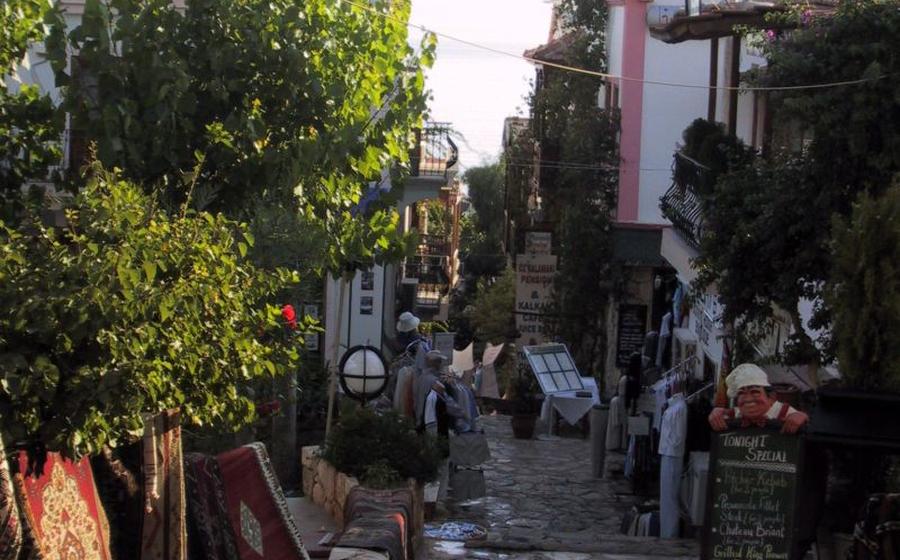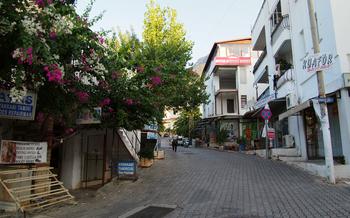
Xanthos Ancient City
- Historical Significance
- Well-Preserved Ruins
- Xanthos Theater: A Stage for Ancient Performances
- Lycian Tombs:
- Acropolis and City Walls
- Museum of Xanthos
- Day Trip from Kalkan:
- Guided Tours
- Photography Opportunities
- Insider Tip:
- Local Cuisine
- Souvenir Shopping
- Best Time to Visit
- Dress Code
- Accessibility
- Off the Beaten Path:
Historical Significance
Xanthos, an ancient city nestled in the picturesque valley of southwestern Turkey, holds immense historical significance as a prominent Lycian city-state. The Lycians, a seafaring people known for their maritime prowess and rich culture, played a crucial role in the region's development. Xanthos served as a thriving trade hub, connecting the Mediterranean Sea with the Anatolian hinterland. Its strategic location allowed the Lycians to establish a vast trading network, exchanging goods and ideas with diverse civilizations. As a testament to its importance, Xanthos minted its own coins, further solidifying its status as a major economic and political center in ancient Lycia.
Well-Preserved Ruins
Remarkably well-preserved, the ruins of Xanthos stand as a testament to the city's former grandeur. As you wander through the ancient streets, you'll encounter a variety of impressive structures, including the theater, agora, and acropolis. The theater, in particular, is a sight to behold with its well-preserved seating tiers and impressive acoustics. Ongoing restoration and maintenance efforts ensure that these ruins remain accessible and awe-inspiring for generations to come.
Xanthos Theater: A Stage for Ancient Performances
The Xanthos Theater, a marvel of ancient engineering, stands as a testament to the city's cultural significance. Constructed during the 4th century BC, this impressive structure boasts a seating capacity of approximately 1,500 spectators. Its remarkable acoustics, achieved through careful design and positioning, ensured that every word spoken on stage could be heard clearly throughout the theater.
In ancient times, the theater hosted a variety of performances, including plays, concerts, and religious ceremonies. The stage, adorned with intricate carvings and sculptures, provided a dramatic backdrop for these events. Imagine the buzz of excitement as the audience gathered, eager to witness the latest theatrical masterpiece or listen to the melodious sounds of a musical ensemble.
One unforgettable anecdote from a past visitor recounts attending a performance in the Xanthos Theater under the starlit sky. The combination of the ancient setting, the captivating performance, and the sheer beauty of the surroundings created an experience that transported them back in time.
Today, visitors can still marvel at the theater's grandeur and imagine the vibrant atmosphere of ancient performances. Whether you choose to sit in the audience or explore the stage, the Xanthos Theater offers a glimpse into the rich cultural heritage of this ancient city.
Lycian Tombs:
The Lycians were renowned for their elaborate rock-cut tombs, which are some of the most distinctive features of Xanthos. These tombs, carved into the sheer cliffs surrounding the city, showcase the Lycians' exceptional craftsmanship and artistry. The intricate carvings and inscriptions on the tombs provide valuable insights into Lycian culture, religion, and funerary practices.
One of the most notable tombs is the "Harpy Tomb," which features a relief depicting mythical harpies carrying away the souls of the deceased. The "Lion Tomb," with its imposing lion sculptures guarding the entrance, is another impressive example. These tombs are a testament to the Lycians' belief in the afterlife and their desire to ensure a comfortable journey for their departed loved ones.
Recent research and efforts to decipher the Lycian language have shed new light on the inscriptions found on the tombs, providing valuable information about Lycian history and mythology. These inscriptions offer glimpses into the lives and beliefs of the ancient Lycians, making Xanthos a treasure trove for archaeologists and historians.
Acropolis and City Walls
Perched atop a hill overlooking the Xanthos Valley, the acropolis served as the city's citadel and last line of defense. Its strategic location provided a panoramic view of the surrounding landscape, allowing the Xanthians to keep a watchful eye on approaching enemies. The acropolis was enclosed by sturdy city walls, reinforced with towers and gates. These fortifications were a testament to the city's determination to protect its independence and sovereignty.
The city walls of Xanthos were not merely defensive structures; they also served as a symbol of the city's power and prosperity. Built with massive blocks of stone, the walls stood tall and imposing, conveying a sense of strength and resilience. The walls featured several gates, each intricately designed and adorned with reliefs and inscriptions. These gates not only provided access to the city but also showcased the artistic prowess of the Xanthian people.
Imagine standing atop the acropolis, gazing out over the sprawling valley below. The sun casts long shadows across the landscape, highlighting the intricate patterns of the city walls. The air is still, and the only sound is the gentle breeze rustling through the olive trees. It's easy to imagine the city's inhabitants going about their daily lives, unaware of the dangers that lurked beyond the walls.
Take a moment to explore the acropolis and city walls, marveling at their grandeur and the ingenuity of their construction. Let the stones whisper tales of ancient battles, political intrigue, and the indomitable spirit of the Xanthian people.
Museum of Xanthos
Housed in a modern building near the ancient city, the Museum of Xanthos is a treasure trove of artifacts that provide a deeper insight into the history and culture of Xanthos. Its collection includes sculptures, inscriptions, and everyday objects that have been excavated from the site.
Among the highlights of the museum are the intricate carvings and reliefs that adorned the city's buildings and tombs. These include depictions of mythological scenes, historical events, and everyday life. Visitors can also admire a collection of Lycian inscriptions, which are still being studied and deciphered by scholars.
The museum also houses a collection of artifacts that shed light on the daily lives of the Xanthians. These include pottery, tools, jewelry, and coins. By exploring these artifacts, visitors can gain a deeper understanding of the economic, social, and cultural aspects of this ancient city.
A visit to the Museum of Xanthos is highly recommended to complement the experience of exploring the ancient city. It provides a comprehensive overview of Xanthos's history and culture, and offers a glimpse into the lives of its inhabitants.
Day Trip from Kalkan:
Xanthos lies a mere 20 kilometers from the charming town of Kalkan, inviting history buffs and nature lovers alike for a captivating day trip. The journey takes approximately 45 minutes by car, offering panoramic views of the Taurus Mountains and the sparkling Mediterranean Sea. Alternatively, you can hop on a local bus, immersing yourself in the daily rhythms of Turkish life.
Upon arrival in Xanthos, the ancient ruins await your exploration. Allocate at least two to three hours to wander through the site, marveling at the well-preserved structures and absorbing the historical significance of this Lycian city-state. Remember to bring comfortable shoes, as the uneven terrain requires sturdy footwear.
For a seamless and enriching experience, consider booking a guided tour through your hotel or a local tour operator. English-speaking guides are readily available, providing insightful commentary and anecdotes that bring Xanthos's past to life.
After exploring the ancient city, savor a delicious Turkish lunch at one of the nearby restaurants. Sample traditional mezes, succulent kebabs, or fresh seafood while enjoying the warm Turkish hospitality.
As the afternoon sun casts long shadows over Xanthos, bid farewell to this ancient marvel, carrying with you memories that will last a lifetime. Return to Kalkan, where you can relax on the beach, indulge in retail therapy, or savor a sunset dinner overlooking the picturesque harbor.
Guided Tours
Exploring Xanthos with a knowledgeable guide can greatly enhance your understanding of its history and significance. English-speaking guides and tour companies are readily available in Kalkan, offering a range of options to suit your preferences and budget.
When choosing a tour operator, check their reputation, read reviews, and ensure they are licensed and experienced. Booking in advance is recommended, especially during peak tourist season, to secure your spot and avoid disappointment.
Guided tours typically cover the main highlights of Xanthos, including the theater, acropolis, and Lycian tombs. Your guide will provide insights into the city's past, explain the significance of the ruins, and answer any questions you may have.
Taking a guided tour is particularly beneficial if you are interested in learning more about the Lycian civilization, the history of Xanthos, and the ongoing archaeological research in the area. It's a great way to make the most of your visit and gain a deeper appreciation for this ancient city.
Photography Opportunities
Xanthos offers a treasure trove of photographic opportunities for both professional and amateur photographers alike. The ancient city, with its well-preserved ruins, provides a dramatic backdrop for capturing the essence of history and culture. Photographers can capture stunning images of the theater, agora, acropolis, and Lycian tombs, each with its own unique architectural features and historical significance.
The surrounding landscapes also offer breathtaking views, with rolling hills, lush forests, and the turquoise waters of the Mediterranean Sea providing a picturesque backdrop for your shots. Sunrise and sunset offer particularly magical moments, as the warm hues of the sky bathe the ruins in a golden glow.
For those who love nature photography, Xanthos is home to a variety of flora and fauna, including colorful wildflowers, ancient olive trees, and soaring birds of prey. Whether you're a seasoned photographer or simply enjoy taking snapshots to remember your travels, Xanthos is a paradise waiting to be captured through the lens of your camera.
Insider Tip:
For a truly unique photographic experience, visit Xanthos during the annual Xanthos Festival, held in July. The festival brings the ancient city to life with traditional music, dance, and theater performances, providing a vibrant and colorful backdrop for your shots. Capture the energy of the festival and the magic of Xanthos under the starry night sky.
Local Cuisine
Visiting Xanthos offers an opportunity to indulge in the flavors of traditional Turkish cuisine. After exploring the ancient ruins, take a break and savor the culinary delights of the region. Nearby restaurants offer a range of options, from traditional mezes and kebabs to fresh seafood caught daily from the Mediterranean Sea. Experience the warmth of Turkish hospitality as you dine on delicious dishes prepared with fresh, local ingredients. Combine your visit to Xanthos with a culinary journey in Kalkan, where you can find charming restaurants serving authentic Turkish cuisine amidst stunning views of the harbor and the surrounding mountains.
Souvenir Shopping
When visiting Xanthos, don't miss the opportunity to take home a piece of history and culture. Kalkan and the surrounding area offer a variety of shops and markets where you can find unique souvenirs and handicrafts.
In Kalkan, stroll through the charming streets and browse the local boutiques for handmade ceramics, jewelry, and textiles. The town is known for its colorful carpets and kilims, which make for beautiful souvenirs.
At Xanthos itself, you can find souvenir stalls selling replicas of ancient coins, pottery, and other artifacts. These make for meaningful mementos of your visit to the ancient city.
For a more immersive experience, visit the Xanthos Museum, where you can admire a collection of artifacts excavated from the site. The museum shop offers a range of replicas and books related to Xanthos's history and culture.
Whether you're looking for a unique gift or a reminder of your travels, you're sure to find something special in Kalkan and Xanthos.
Best Time to Visit
The best time to visit Xanthos is during the shoulder seasons, which fall in spring (April-May) and autumn (September-October). During these months, the weather is pleasant, with warm days and cool nights, making it ideal for exploring the ancient city. The crowds are also smaller, allowing you to enjoy a more intimate and authentic experience.
Summer (June-August) can be hot and crowded, especially in July and August. If you do visit during this time, be sure to start your exploration early in the morning or late in the afternoon to avoid the midday heat. Winter (November-March) can be cold and rainy, with occasional snowfall. While the weather may not be ideal for sightseeing, it can be a magical time to visit Xanthos, with fewer tourists and a chance to experience the ancient city in a different light.
Regardless of when you choose to visit, be sure to come prepared with comfortable clothing and footwear, as you will be doing a lot of walking on uneven surfaces. Also, remember to bring plenty of water, especially during the summer months.
Dress Code
When visiting Xanthos, it is essential to dress respectfully, as it is a historical and religious site. Although Turkey is a predominantly Muslim country, visitors are not required to wear traditional Islamic attire. However, modest dressing is recommended, especially for women. Avoid wearing shorts, tank tops, or revealing clothing. Opt for lightweight, loose-fitting pants or skirts that cover the knees and a shirt or blouse that covers the shoulders. Comfortable footwear is also essential, as you will be doing a lot of walking on uneven surfaces. Sandals or sneakers are good options. Remember, dressing appropriately shows respect for the local culture and helps preserve the sanctity of the ancient city.
Accessibility
Xanthos is committed to ensuring accessibility for all visitors, regardless of their abilities. Visitors with disabilities can explore the ancient city with ease, thanks to various accessibility features and accommodations. Ramps and designated pathways allow wheelchair users to navigate the site smoothly. For those who need additional assistance, wheelchairs are available for rent at the Visitor Center.
It is recommended to inform the staff in advance if you have specific accessibility requirements. They will be more than willing to assist you and provide any necessary support to ensure a safe and enjoyable visit. By embracing inclusivity, Xanthos welcomes travelers from all backgrounds to immerse themselves in the wonders of this ancient Lycian city.
Off the Beaten Path:
Beyond the main tourist attractions of Xanthos, there lies a hidden gem waiting to be discovered. Just a short walk from the ancient city, nestled amidst olive groves and serene landscapes, you'll find the picturesque village of Pydnai. This charming village offers a glimpse into traditional Turkish life, with its narrow cobblestone streets, whitewashed houses adorned with colorful flowers, and friendly locals who warmly welcome visitors. Take a leisurely stroll through Pydnai, savor the tranquility, and immerse yourself in its authentic atmosphere. Indulge in a delicious home-cooked meal at a local restaurant, engage in conversations with the villagers, and discover the hidden treasures that make this village a true gem off the beaten path. Pydnai is a perfect escape from the tourist crowds, allowing you to experience the genuine essence of Turkey's rich culture and heritage.









